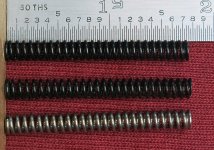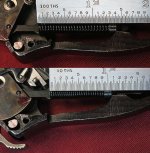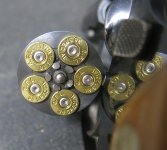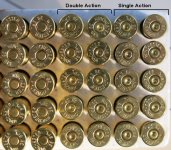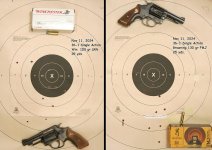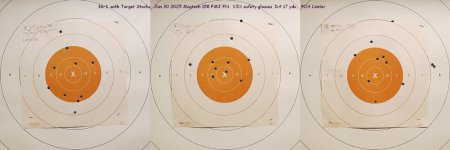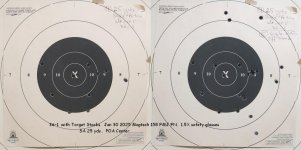Matt_X
Member
- Joined
- Mar 4, 2023
- Messages
- 349
- Reaction score
- 323
J-frame hammer springs
Quick update:
Thank you Mercury!

The new black spring is slightly longer. If everything else is the same as the old black spring (and it seems very close), then assuming a modulus of elasticity of 12x10^6, the spring rate of the old black spring is around 13 lb/in, new spring is around 14 lbs/in. That could be the difference between using a good vernier vs. a cheap dial caliper. However the new one's free length is longer, so it will apply more force for any given compression.
The spring rate of the new silver spring calculates to be closer to 17.5 lbs/in. Length is between the old black and the new black.
I bought a good used round stirrup/hammer strut. Installed that with the new black spring. Also took a one little burr off the side plate where it was just scratching the hammer. But that won't effect the weight test.
Testing the result of the spring change using the same method as previously posted, result was only another ounce at best. So its up to 59 oz.
However, the difference between primers firing and not firing has been the difference between single action and double action. The static force as measured doesn't change between SA and DA. So its a good reference point, but doesn't tell the whole story.

Next step will either be to test the installed spring and stirrup with the Fiocchi, or change to the silver spring and measure the hammer force. Depends on whether I go to that range before I get time in the shop.
Quick update:
Thank you Mercury!
The new black spring is slightly longer. If everything else is the same as the old black spring (and it seems very close), then assuming a modulus of elasticity of 12x10^6, the spring rate of the old black spring is around 13 lb/in, new spring is around 14 lbs/in. That could be the difference between using a good vernier vs. a cheap dial caliper. However the new one's free length is longer, so it will apply more force for any given compression.
The spring rate of the new silver spring calculates to be closer to 17.5 lbs/in. Length is between the old black and the new black.
I bought a good used round stirrup/hammer strut. Installed that with the new black spring. Also took a one little burr off the side plate where it was just scratching the hammer. But that won't effect the weight test.
Testing the result of the spring change using the same method as previously posted, result was only another ounce at best. So its up to 59 oz.
However, the difference between primers firing and not firing has been the difference between single action and double action. The static force as measured doesn't change between SA and DA. So its a good reference point, but doesn't tell the whole story.
Next step will either be to test the installed spring and stirrup with the Fiocchi, or change to the silver spring and measure the hammer force. Depends on whether I go to that range before I get time in the shop.
Attachments
Last edited:

